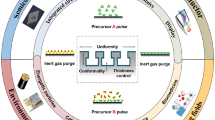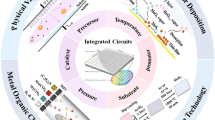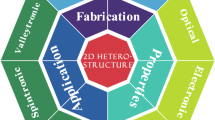Abstract
In today’s world, semiconductor nanowire GAA-MOSFET devices have stimulated a lot of scientific research interest in the field of semiconductor. It has been observed as one of the strong and gifted structure for future generation nano-scaled devices and integrated circuits (ICs). Basically, the term nanotechnology is the key powerhouse of semiconductor device engineering and technology to produce and operate the materials at nano-meter scale (10−9 m or 1 nm) either by top-down approach where the bulk materials are converted to a group of nano particles (atoms) or by bottom-up approach where the single groups of nano particles (atoms) are converted to the bulk materials. Nanowire GAA MOSFET is considered as work horse in semiconductor industry due to great electrostatic controllability over the channel and tight coupling. This review article investigates the different structural designs of nanowire devices using nanotechnology approaches for future device applications.
Similar content being viewed by others
Data Availability
The authors confirm that the data supporting the findings of this study are available within the article, its supplementary materials or below mentioned references.
References
Ermolov V, Heino M, Karkkainen A, Lehtiniemi R, Nefedov N, et al. (2007) Significance of nanotechnology for future wireless devices and communications. IEEE 18th Int Symposium on Personal, Indoor and Mobile Radio Communications, Athens 1–5
Kannaparthy R, Kanaparthy A (2011) The changing face of dentistry: nanotechnology. Int J Nanomedicine 6:2799–2804
Iadiz MAR, Bamedi M, Fakour SR (2017) Periodontal diseases and recently applied nanotechnology: a review article. Health 9:345–351
Pease RF, Chou SY (2008) Lithography and other patterning techniques for future electronics. IEEE 96:248–270
Thompson SE, Parthasarathy S (2006) Moore's law: the future of Si microelectronics. Mater Today 9:20–25
Keyes RW (2001) Fundamental limits of silicon technology. IEEE 89:227–239
Balzani V (2005) Nanoscience, and nanotechnology: a personal view of a chemist. Small 1:278–283
Balzani V (2008) Nanoscience, and nanotechnology: the bottom-up construction of molecular devices and machines. Pure Appl Chem 80:1631–1650
Lu W, Lieber CM (2007) Nanoelectronics from the bottom up. Nat Mater 6:841–850
Gunawan O, Sekaric L, Majumdar A, Rooks M, Appenzeller J, Sleight JW (2008) et al. Nano Lett 8:1566–1571
Zervas M, Sacchetto D, Micheli GD, Leblebici Y (2011). Microelectron Eng 88:3127–3132
Westwater J, Gosain DP, Tomiya S, Usui S, Ruda H (1997). J Vac Sci Technol B15:554–557
Rost J-M (2010) Nanoscience and nanotechnology in physics and chemistry. Research Perspectives of the Max Planck Society 1:40–41
Kannaparthy R, Kanaparthy A (2011) The changing face of dentistry: nanotechnology. Int J Nanomedicine 6:2799–2804
Komatsu H, Ogasawara A (2005). Appl Nanotechnol Electron 16:36–45
Rae A (2005) Real life applications of nanotechnology in electronics. OnBoard Technology 36-9
Dennard RH, Gaensslen FH, Yu HN, Rideout VL, Bassous E, Leblanc AR (1999) Design of ion-implanted MOSFET's with very small physical dimensions. Proc IEEE 87:668–678
Khan HN, Hounshell DA, Erica RH (2018) Fuchs, science and research policy at the end of Moore’s law. Nature Electronics 1:14–21
Colinge JP (2014) Multigate transistors: pushing Moor’s law to the limit, Internationalconference on Simulation of Semiconductor Processes and Devices SISPAD, IEEE, 313–316,
Wu YC, Chang TC, Liu PT, Chou CW, Wu YC, Tu CH et al (2006) High-performance metal-induced lateral-crystallization Polysilicon thin-film transistors with multiple nanowire channels and multiple gates. IEEE Trans Nanotechnol 5:157–162
Ishikawa F, Buyanova I (2017) Novel compound semiconductor nanowires: materials, devices, and applications. CRC Press, Boca Raton
Park J-T, Colinge J-P (Dec. 2002) Multiple-gate SOI MOSFETs: device design guidelines. IEEE Transactions on Electron Devices 49(12):2222–2228
Singh N, Agarwal A, Bera LK, Liow TY, Yang R, Rustagi SC, Tung CH, Kumar R, Lo GQ, Balasubramanian N, Kwong DL (2006) High-performance fully depleted silicon nanowire gate-all-around CMOS devices. IEEE Electron Device Letters 27(5):383–386. https://doi.org/10.1109/LED.2006.873381
Gu JJ, Liu YQ, Wu YQ, Colby R, Gordon RG, Ye PD (2011) First experimental demonstration of gate-all-around III-V MOSFETs by top-down approach, 978-1-4577-0505, IEEE, IEDM11 pp. 769–772
Assad F, Ren Z, Vasileska D et al (2000) On the performance limits for Si MOSFET’s: a theoretical study. IEEE Transactions on Electron Devices 47(1):232–240
Srivastava VM, Yadav KS, Singh G (2011) Design and performance analysis of double-gate MOSFET over single-gate MOSFET for RF switch. Microelectron J 42(3):527–534
Sun VM, Damrongplasit N, Shin C, Liu TJK (2011) Variation study of the planar ground-plane bulk MOSFET, SOI FinFET, and trigate bulk MOSFET designs. IEEE Trans Electron Devices 58:3294–3299
Colinge P (2007) Multi-gate SOI MOSFETs. Microelectron Eng 84(9–10):2071–2076
Li C, Zhuang Y, Han R (2011) Cylindrical surrounding-gate MOSFETs with electrically induced source/drain extension. Microelectron J 42:341–346
Siddaiah N, Venkatesh D, Surendra PS, Vijitha N (2019) Design and modelling of high sensitivity dual gate MOSFET integrated MEMS microphone. International Journal of Innovative Technology and Exploring Engineering 8(7):393–397
Madhuri BD, Sunithamani S (2019) Design of Ternary D-latch using graphene nanoribbon field effect transistor. Proceedings - International Conference on Vision Towards Emerging Trends in Communication and Networking, ViTECoN 2019:610–614
Anil Kumar M, Sai Kiran YNS, Jagadeesh U Design and simulation of nanowire FET. Mechanics, Material Science and Engineering 9(1):211–216
Ahmad Saidulu S, Sai Vineeth R, Tanmayee Y, Meenakshi B (2020) Performance measures of different gate oxide materials in gate all around FET. International Journal of Recent Technology and Engineering 9(2)
Jena B, Dash S, Routray SR, Mishra GP (2019) Inner-gate-engineered GAA MOSFET to enhance the electrostatic integrity. Nano 14(9):1950128–19501-8
Li M, Yeo KH, Suk SD, Yeoh YY, Kim D-W, Chung TY, Oh KS, Lee W-S (2009). Symposium VLSI technology 75:94–95
Mertens H, Ritzenthaler R, Hikavyy A, Kim M-S, Tao Z, Wostyn K, Chew SA, De Keersgieter A, Mannaert G, Rosseel E et al (2016). IEEE Symposium VLSI Technology:1–2
Thomas P, Ashokbabu A, Ernest Ravindran RS, Vaish R (2019) Dielectric properties of nylon 11/CaCu3Ti4O12 (CCTO) nanocomposite films with high permittivity. IEEE Trans Dielectr Electr Insul 26(2):568–575
Sridhar Yesaswi C, Srinivasu C, Hanumantha Rao Y (2019) View on transport and quantum confinement properties of nano-scale materials – applications 10(1):568–569
Lieber CM (2011) Semiconductor nanowires: a platform for nanoscience and nanotechnology. MRS Bull 36:1052–1063
Jena B, Dash S, Mishra GP (2016) Electrostatic performance improvement of dual material cylindrical gate MOSFET using work-function modulation technique. Superlattice Microst 97:212–220
Ramakrishna BS, Jena B, Dash S, Mishra GP (2017) Investigation of electrostatic performance for a conical surrounding gate MOSFET with linearly modulated work- function. Superlattice Microst 101:152–159
Naif YH (2015) A review on transistors in nano dimensions. Int J Eng Tech Sci 4:8–18
Lu W, Lieber CM (2006) Topical review: semiconductor nanowires. J Phys D Appl Phys 39:387–406
Cui Y, Zhong Z, Wang D, Wang WU, Lieber CM (2003) High performance silicon nanowire field effect transistors. Nano Lett 3:149–152
Lu W, **e P, Lieber CM (2008) Nanowire transistor performance limits and applications. IEEE Trans Electron Dev 55:2859–2876
Zhang A, Zheng G, Lieber CM (2016) Nanowires: building blocks for Nanoscience and nanotechnology; Springer International Publishing: Switzerland, 978-3-319-41981-7
Lu W, Lieber CM (2006) Semiconductor nanowires. J Phys D Appl Phys 39(21):R387–R406
Lieber CM, Wang ZL (2007) Functional nanowires. MRS Bull 32(02):99–108
Z. Zhong, C. Yang, C.M. Lieber (2008) Silicon nanowires and nanowire heterostructures, in Nanosilicon, ed. by V. Kumar, Elsevier, Amsterdam, pp. 176–216
Garnett E, Mai L, Yang P (2019) Introduction: 1D nanomaterials/nanowires. Chem Rev 119(15):8955–8957
Jena B, Pradhan KP, Dash S, Mishra GP, Sahu PK, Mohapatra SK (2015) Performance analysis of undoped cylindrical gate all around (GAA) MOSFET at subthreshold regime. Adv Nat Sci Nanosci Nanotechnol 6:035010–035013
Michaelson HB (1977) The work function of the elements and its periodicity. J Appl Phys 48:4729–4733
Ren C (2006) Work function and process integration issues of metal gate materials in CMOS technology, NUS
Jena B, Pradhan KP, Dash S, Mishra GP, Sahu PK, Mohapatra SK Investigation on cylindrical gate all around (GAA) to nanowire MOSFET for circuit application. Electronics and Energetics 28:637–643, 2015
Pal A, Sarkar A (2014) Analytical study of dual material surrounding gate MOSFET to suppress short-channel effects (SCEs). Engineering Science and Technology, an International Journal 17:205–212
Dubey S, Santra A, Saramekala G, Kumar M, Tiwari PK (2013) An analytical threshold voltage model for triple-material cylindrical gate-all-around (TM-CGAA) MOSFETs. IEEE Trans Nanotechnol 12:766–774
Suveetha Dhanaselvam P, Balamurugan NB (2013) Analytical approach of a nanoscale triple-material surrounding gate (TMSG) MOSFETs for reduced short-channel effects. Microelectron J 44:400–404
Sarkar A (2014) Study of RF performance of surrounding gate MOSFET with gate overlap and underlap. Adv Nat Sci Nanosci Nanotechnol 5:035006
Jena B, Dash S, Mishra GP (2016) Effect of underlap length variation on DC/RF performance of dual material cylindrical MOS. International journal of numerical modelling: electronic networks, devices and fields 30:e2175
Pratap Y, Ghosh P, Haldar S, Gupta RS, Gupta M (2014) An analytical subthreshold current modeling of cylindrical gate all around (CGAA) MOSFET incorporating the influence of device design engineering, 45, 408–415
Sentaurus Device User Guide, Synopsys, Inc., Mountain View, USA, 2014
Acknowledgements
The Authors would like to thank School of Electronics Engineering, Vellore Institute of Technology,Vellore, for their support to use Sentaurus TCAD simulation tool to carry out this simulation.
Funding
There is no funding for this research work.
Author information
Authors and Affiliations
Contributions
KrutideepaBhol- Conceptualization, methodology, simulation and investigation,
Biswajit Jena- Writing original draft preparation,
Umakanta Nanda- reviewing and editing.
Corresponding author
Ethics declarations
Conflict of Interest
The authors declare that they have no conflict of interest.
Compliance with Ethical Standards
This article does not contain any studies with human participants or animals performed by any of the authors.
Consent to Participate
All authors freely agreed and gave their consent to participate on thiswork.
Consent for Publication
All authors freely agreed and gave their consent for the publication of this paper.
Additional information
Publisher’s Note
Springer Nature remains neutral with regard to jurisdictional claims in published maps and institutional affiliations.
Rights and permissions
About this article
Cite this article
Bhol, K., Jena, B. & Nanda, U. Silicon Nanowire GAA-MOSFET: a Workhorse in Nanotechnology for Future Semiconductor Devices. Silicon 14, 3163–3171 (2022). https://doi.org/10.1007/s12633-021-01136-x
Received:
Accepted:
Published:
Issue Date:
DOI: https://doi.org/10.1007/s12633-021-01136-x




